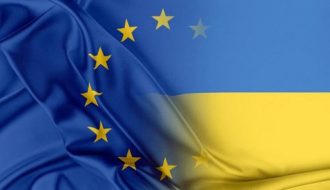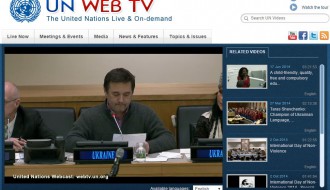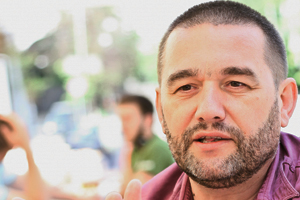The Ukrainian language has strengthened its positions only in certain areas – the results of an analytical review
Despite the Revolution of Dignity and the rise of patriotism in Ukraine, a process of gradual russification continues. These are the results of an analytical overview, “The State of the Ukrainian Language in Ukraine in 2014-2015”, which was published by the NGO movement “Prostir Svobody”. This document, presented in Kyiv on July 8, is based on data from government statistics, sociology and the movement’s own research, conducted by volunteers in all of Ukraine’s regions.
As compared to previous years, the portion of Ukrainian-language newspapers and magazines has decreased, the Russian language continues to dominate in national television and radio broadcasting. The position of the Ukrainian language has strengthened slightly in the educational sphere. The language situation in the services sector is very dependent on the region: in the East and South the Russian language clearly dominates, though the rights of Ukrainian-speaking clients are also often violated in Central Ukraine and in Kyiv.
The authors of the review note that the principal negative factor which stimulates the diminishing role of the Ukrainian language in the most important social spheres is the infamous language law of Kivalov-Kolesnichenko. This law, pushed through by Yanukovych in 2012, remains in force despite strong criticism from the Council of Europe, the OSCE and Ukrainian experts.
At the same time, a fast and forced russification is taking place on the occupied territories of the Crimea, the Donetsk and Luhansk oblasts, where the Ukrainian language has been driven from practically all spheres of social life.
The portion of schoolchildren who are taught in the Ukrainian language in 2014-2015 reached 90.8%, an increase of 9% over the course of one year. However, this increase is tied, first and foremost, to the fact that statistics no longer take into account schools located on the occupied territories. The real increase in the number of schoolchildren who are taught in Ukrainian stands at the level of tenths of a percentage point and in several oblasts this indicator has even decreased. The fewest number of schoolchildren are taught in the Ukrainian language in the Donetsk oblast (59%), the most in the Rivne oblast (100%). In Kyiv 97% of schoolchildren are taught in Ukrainian, 98% in the Poltava oblast, 81% in the Dnipropetrovsk oblast, 74% in the Kharkiv oblast and 70% in the Odesa oblast.
Among children in the first grade 89% were taught in the Ukrainian language in 2014-15. The same number of graduates, 89%, chose the Ukrainian language for exams in the external independent testing in 2014.
In the cinemas the total number of films which were dubbed or voiced in the Ukrainian language in 2014 was 65.5% of the total, in 2015 this figure was at 83.8% (up to the start of June). The rest of the films, usually voiced in Russian, were subtitled in Ukrainian. The sharp drop in the number of such films in 2015 is directly tied to the decrease in the rental of films made in Russia.
The number of newspapers which are published in the Ukrainian language continues to drop and stood at 29.5% in 2014. As regards magazines and other periodic literature the situation is catastrophic, only 9.9% of the total circulation produced in 2014 was in the Ukrainian language (for comparison, in 2010 this indicator stood at 19.6%).
Only 55% of books printed in Ukraine in 2014 were in the state language and most of these were educational textbooks, while the mass import of books from Russia is greater than the number of books printed in Ukraine. At the same time whereas the percentage of Ukrainian books remains constant, the actual number of books printed in Ukraine is decreasing in absolute numbers.
In prime time, on the 8 most popular TV channels, the share of Russian language in broadcasting stood at 44%, in Ukrainian the figure was 30%. At the same time the share of “dual language” broadcasts increased to 26%.
The number of Ukrainian language songs broadcast by the 5 most popular radio stations amounts to a miserly 5% from the total number of songs broadcast.
Sociological research conducted in 2015 demonstrated that an absolute number of residents of oblast centers in Western Ukraine and a relative majority in central Ukraine communicate at home exclusively in the Ukrainian language. This indicator is 93% in Lviv, 70% in Vinnytsia, 52% in Cherkasy, 47% in Poltava, 27% in Kyiv. At the same time Russian is used for communicating at home by 84% in Kharkiv, 78% in Odesa, 58% in Dnipropetrovsk, 41% in Chernihiv, 32% in Kyiv and 26% in Kirovohrad. A substantial number of city residents communicate at home both in Ukrainian and in Russian.
According to the results of the monitoring conducted in cafes and restaurants in all of the oblast centers (other than those that are occupied) and in the city of Kryvyi Rih, only 58% of food establishments have a signboard in Ukrainian language, only 63% have a menu in Ukrainian and only in 53% does the staff serve Ukrainian-speaking clients in the Ukrainian language. At the same time, the situation differs greatly depending on the region. In southern and eastern cities Ukrainian-language clients are almost always communicated with in Russian by staff.
The authors of the review draw attention to the direct link established by sociological data between the language used by respondents and their receptiveness to Russian propaganda. In their view, in order to protect the future and security of its citizens, the state should implement measures for the real confirmation of the Ukrainian language in all spheres of social life on the entire territory of the country, as is foreseen by the Constitution. First of all, the language law of Kivalov-Kolisnichenko should be changed to a new law which will correspond to the Constitution and to European practices.



